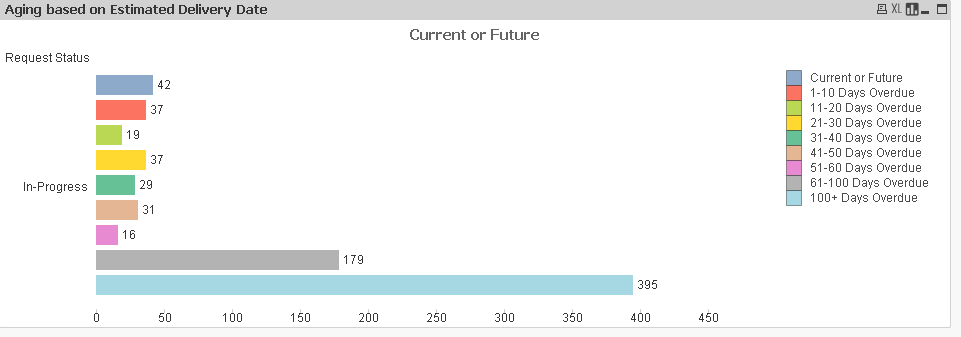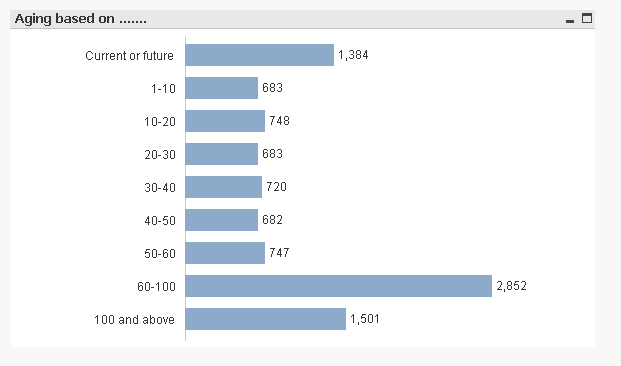Unlock a world of possibilities! Login now and discover the exclusive benefits awaiting you.
- Qlik Community
- :
- All Forums
- :
- QlikView App Dev
- :
- Creating Aging Buckets within QlikView
- Subscribe to RSS Feed
- Mark Topic as New
- Mark Topic as Read
- Float this Topic for Current User
- Bookmark
- Subscribe
- Mute
- Printer Friendly Page
- Mark as New
- Bookmark
- Subscribe
- Mute
- Subscribe to RSS Feed
- Permalink
- Report Inappropriate Content
Creating Aging Buckets within QlikView
Hello,
I need help creating Aging Buckets. I think the best way to do that is in Load script. So far I was able to accomplish the following:
1) Calculated number of days using the following script:
Load Interval(Now()-[Estimated Delivery Date],'dd') as [Estimated Delivery Date Aging],
Interval(Now()-[Actual Submit Date],'dd') as [Actual Submit Date Aging],
Interval(Now()-[Reservation Created Date],'dd') as [Reservation Created Date Aging],
2) As a next step, I need to create buckets based on recently created 'Estimated Delivery Date Aging'. However, I get an error saying that 'Estimated Delivery Date Aging field doesn't exist'
3) I was able to create aging buckets within a graph. However, I'm not able to select individual aging category.

Here are the properties:

Ultimately, I need to be able to drill down to individual aging buckets (which I am not able to do at this point)
I appreciate your help!
Accepted Solutions
- Mark as New
- Bookmark
- Subscribe
- Mute
- Subscribe to RSS Feed
- Permalink
- Report Inappropriate Content
- Mark as New
- Bookmark
- Subscribe
- Mute
- Subscribe to RSS Feed
- Permalink
- Report Inappropriate Content
If your buckets were all of the same size, you could use the class function in your script. You can create a table with the boundaries of each bucket and use the intervalmatch function to associate the age with the buckets.
- Mark as New
- Bookmark
- Subscribe
- Mute
- Subscribe to RSS Feed
- Permalink
- Report Inappropriate Content
Instead of creating multiple expressions, classify your aging values in the script, here is a discussion showing multiple approaches on a similar topic:
creating an age group from a date field
2) If you want to use a field you just created in your script, you need a preceding load to reference this field:
LOAD *,
if( A > 10,1,0) as Flag;
LOAD
if( B = 'X', RAND()*20) as A,
B
FROM ...;
- Mark as New
- Bookmark
- Subscribe
- Mute
- Subscribe to RSS Feed
- Permalink
- Report Inappropriate Content
- Mark as New
- Bookmark
- Subscribe
- Mute
- Subscribe to RSS Feed
- Permalink
- Report Inappropriate Content
Massimo,
Thank you so much for your response! I was able to recreate a graph. However, I'm not sure how I can make the buckets look like the original graph (assuming equal buckets)
I addition, the buckets should be assigned following this logic:
Current of Future - <=0
1-20 Days Overdue
21-40 Day Overdue
...
Over 100 days overdue

- Mark as New
- Bookmark
- Subscribe
- Mute
- Subscribe to RSS Feed
- Permalink
- Report Inappropriate Content
not sure to understand
using my solution you can change the name and/or number and/or limit of buckets in the table RangeForIntervalMatch
- Mark as New
- Bookmark
- Subscribe
- Mute
- Subscribe to RSS Feed
- Permalink
- Report Inappropriate Content
Thank you Massimo! The graph works perfectly!![]()
